|
 |
|
|
|
Privacy Policy |
Editorial Policy |
Profit Policy |
Join the Association |
List of Members |
Contact us | Index
|
Links
Merchandise | Print this page |
|
Back Go to page:
1
2
3
4
5
6
7
8
9
10
11
12
13
14
15
16
17
18
19
20
Forward
|
| |
|

Out in the Shed
with Ted.
Ted McEvoy. |
|
|
|

Click the pic above to access the Kedron Wavell
Services club web site. |
|
University Study.
Monash
University in Melbourne is requesting Australian military who served
in Asia during 1946 – 1988 to assist with a study they
are conducting.
If you served
in Asia (Japan, Malaysia, Singapore and Hong Kong
) during this
period, you may wish to contribute to the study.
If
interested, visit
http://artsonline.monash.edu.au/australias-asian-garrisons
|
|
|
|
DVA Grants.

The Minister for Veterans’ Affairs, Dan Tehan, advises that a new
grants opportunity has been announced and which is called the
“Supporting Younger Veterans (SYV) grants program.”
The SYV grants program is being established to support the needs of
younger veterans as they leave the Australian Defence Force and
integrate back into civilian life, with all the challenges that
accompany that unique transition.
There is no maximum or minimum amount that can be sought for this
grants program; however, all applications will be assessed on their
merit and subject to a cost benefit analysis.
Funding can be used for initiatives that:
-
develop capability within the veteran community that services the
unique needs of younger veterans;
-
support the development of well researched and tailored services for
younger veterans;
-
fund organisations that can sustainably deliver services to younger
veterans now and into the future;
-
increase collaboration amongst organisations to expand services and
harness existing expertise; and/or
-
increase awareness of younger veteran issues and or services within
the Australian and veteran communities, where doing so would benefit
younger veterans.
-
The SYV grants program provides $4.25 million over five years to
Ex-Service Organisations (ESOs) to encourage partnerships that will
deliver innovative and sustainable services for younger veterans and
build community capacity to meet the needs of younger veterans. The
grants will also help raise awareness of the important issues faced
by younger veterans.
Applications for a $250,000 special round of SYV grants will close
in late May 2017 with successful applicants announced in June 2017.
Future rounds of the grants which will allocate $1m each financial
year, will open on the 1st July each year, commencing
2017, and will close on the 1st September each year,
until 2021.
Applicants can apply for grants through the DVA website
HERE. There is ample information on how to apply and a form
which applicants can download and fill in.
DVA staff members are available to assist with the development of
applications. For further information, please contact the Grants
Section in DVA’s National Office on 1800 026 185 or email
DVA.Grants.Processing.Team@dva.gov.au.
|
|
Vietnam Vets Museum, Phillip Island.
On Saturday 5th August at 2pm, Caribou 231 will be unveiled at
Phillip Island. Visitors will include:
-
Greg Hunt - Federal Minister for Health, Federal Minister for Sport.
Member for Flinders.
-
Dan Tehan -Federal Minister for Veterans Affairs (amongst others)
Member for Wannon.
-
Josh Frydenberg - Federal Minister for the Environment and Energy.
Responsibilities for Heritage. Member for Kooyong.
-
John Erin - State Minister for Veterans. Minister for Tourism and
Major Events. Member for Lara.
The Museum is asking for names of interested connections (eg: RTFV
and 35 SQN), and will issue invitations.
If you are interested, please email Dave Grierson.
Dgrierson@melbpc.org.au
|
|
|
|
Government passes Gold Cards for BCOF
and BNT veterans’ legislation.
Minister for Veterans’ Affairs Dan Tehan today (15 June) called on
surviving participants of the British Nuclear Test (BNT) program in
Australia and veterans who served as part of the British
Commonwealth Occupation Force (BCOF) to register for free health
care.
Mr Tehan said the Department of Veterans’ Affairs (DVA) Budget
passed the Senate on the 15th June.
Mr Tehan said the passage of the Bill meant the Government’s $133.1
million program to provide a Gold Card to the surviving participants
of the BNT program in Australia and veterans who served as part of
the BCOF would come into effect from 1 July.
“The Gold Card can be used by eligible former members of the
Australian Defence Force to pay for their health care,” Mr Tehan
said.
“This Budget measure will also provide this health care coverage for
affected pastoralists, Indigenous people and other civilians
determined to be within the same vicinity as the participants of the
BNT. I strongly encourage anyone who believes they are eligible
under this program to contact DVA and begin the process so
everything is in place for the 1 July start."
“Starting the process now will help people get their required
paperwork in order in time for 1 July when DVA will be able to begin
processing applications.”
DVA can be contacted on 133 254 or 1800 555 254 for regional
callers.
|
|
|
NASA’s robot Curiosity landed on Mars. Early
pictures show no signs of empty VB cans, old car bits, cigarette
butts, playboy magazines, dirty washing or unmade beds. This makes
it very clear that men are not from Mars.
|
|
 |
|
Kedron-Wavell Services Club is
Brisbane North’s premier entertainment destination! With plenty of
free and ticketed entertainment every day of the week Kedron-Wavell
showcases some of the biggest national and international acts in
their state of the art showroom.
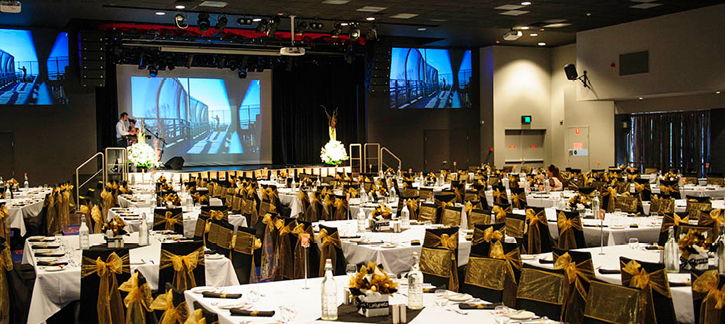
Some of the wonderful live shows coming in the near future in the
Club's Blue Pacific Ballroom include:
-
"The 2 of us, Up
close and personal", a presentation by Australia's Leading
Opera and Musical Stars and,
-
"Troy
Casser-Daley, Things I carry around" - see
HERE.
Tickets for these shows
usually sell out quickly so you would be best advised to book early.
You can get tickets from Ticketmaster
HERE. |
|
Constructive meeting.
Rick
Ryan.
Recently I attended a meeting with Dan Tehan, MP, Minister for
Veterans Affairs, John Carter OAM, DCM and Andrew Hastie MP, at the
North Dandalup Tavern, WA. There were a number of other
veterans at the meeting and we listened to Dan Tehan give us the
details on just what the extra $350m allocated to his portfolio
would be spent.
I had recently attended a meeting of ESOs at DVA HQ in Perth where
the subject was on the transformation of DVA in the future hence my
reason for sending this email. DVA is finally moving into the
digitalisation era. The concept is that anyone who joins the Defence
forces will have their service details relayed to DVA from day one.
Over their service career, should they travel overseas on
operational duties, receive injuries or illnesses then all of this
information will be transferred to DVA. This is to assist the
service member in that when any claim is made then DVA will have all
their details and service history readily available.
Other aspects of the transformation process is for quick claims
processing. Dan Tehan indicated in his speech to us that not only
would the afore-mentioned occur but there would be an amalgamation
of information from Defence, DVA and Comsuper whereby the necessity
to go to various doctors and specialists when a claim is made would
be reduced significantly. For example, if you were being treated by
Defence doctors, specialists for injuries, then you would not have
to go through the same hurdles with DVA or Comsuper. In other words,
the determinations by your doctor/specialist in Defence would be
accepted.
No doubt there would have to be a fair bit of streamlining and
cohesion between all departments involved but I can see the claims
process times being reduced dramatically.
Most of the above will not affect us as we are in our twilight years
but for the younger service men and women it should be a blessing.
Dan also spoke about the Gold Card being given to atomic testing
veterans and of course the acceptance now of all mental conditions
for those who have served. You do not have to jump through any
hurdles you can just go and get treatment for your mental problems.
|
|
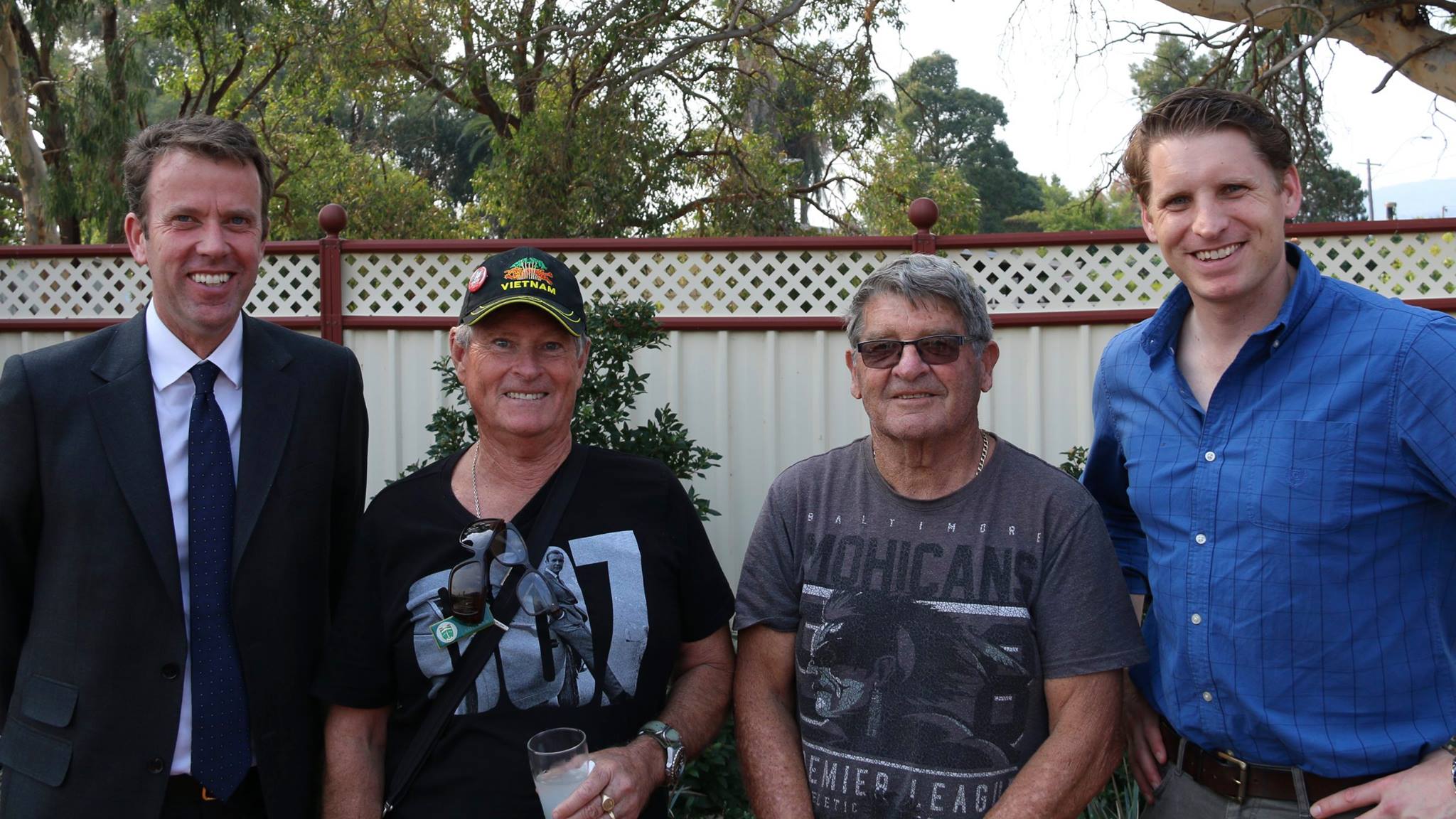 |
L-R: Dan Tehan MP, Minister of Veterans Affairs, Rick Ryan,
John Carter OAM, DCM and Andrew Hastie MP (ex- SAS),
Federal MP for Canning (WA) and of course with his military
background quite easy to talk to.
|
|
I have given only a brief narrative of what this meeting was about.
If you want any further information about the direction that DVA is
heading then speak to representatives of your ESOs. Suffice to say
that I was very impressed from my meeting with DVA on just what is
being proposed for the future of the department.
At the time of the meeting DVA were anxiously awaiting the outcome
of the Budget release. Well the government has allocated $150m of
the $350m for the transformation.
Dan Tehan is a country lad and in my opinion I see a bright future
for both him and Andrew Hastie in politics. They both have a greater
understanding of veterans than I have seen in previous occupants.
Andrew is involved in a number of Committees that revolve around
Defence and veterans, so I consider us to be in good hands.
|
Always be yourself - everyone else has been
taken.
|
|
|
|
Latest Scam.
If you receive a phone
call and somebody asks, “can you hear me”, don’t say anything and
just hang up the phone. Police have sent out a warning about an
elaborate phone scam involving this phrasing, which has arrived in
Australia after doing the rounds in the United States and the UK.
The ‘can you hear me?’ phone scam is brief and seems harmless on the
surface, but has the potential to end in fraud.
It involves a scammer
calling a business or home number and once the person answers the
scammer asks ‘can you hear me?’ The caller may ask it several times,
to which most people on the other end would simply reply with ‘yes’.
The scammer then records the ‘yes’ response and ends the call. That
recording of the victim’s voice can then be used to authorise
payments or charges in the victim’s name with voice recognition.
Because it is the person’s voice authorising transactions, it makes
it hard to dispute later if a victim claims they have been scammed.
Sunshine Coast (Qld)
Police warned anyone who received calls of this nature had “serious
and legitimate reasons to be concerned”. “We’re now sharing this
post state-wide as we believe it to be hitting many areas,” police
warn. To avoid being scammed, police have encouraged people to share
the warning. If you receive a ‘can you hear me?’ call, hang up, and
don’t respond. If you do respond with a ‘yes’ contact your bank and
monitor your accounts closely.
|
|
New
York Incident.

An 18-year-old woman has died and
several others were injured after a speeding car ploughed into a
crowd of pedestrians in New York City’s Times Square on the 18th
May. The victim has been named as Alyssa Elsman, a
tourist who was visiting the city from Portage in the US state of
Michigan. New York City Fire Department said about 22 people have
been injured when a car driven by a low animal mounted the pavement
and collided with a number of pedestrians. It is nothing short of a
miracle that not more people were killed.
New York Police
Department said Richard Rojas (right), a 26-year-old US Navy
veteran, was arrested and taken into custody.
Click
HERE to see video of
this animal driving into innocent people.
|
|
Red wine is good for you!
A wealth of research says red wine keeps your brain younger and
healthier.
Red wine might be good for the heart, but it kills off brain cells,
right? Researchers have known for a while that red wine can delay
the onset of neurodegenerative diseases such as Alzheimer’s and
Parkinson’s – meaning that it actually protects against brain-cell death. If this sounds
counterintuitive and perplexing, the scientists could only agree.
Until recently, they weren’t sure what was going on. The celebrated
health-giving antioxidants in red wine are assumed to play a part by
reducing oxidative stress – where your body struggles to detoxify
dangerous chain reactions at an atomic level – but scientists know
that other factors are at play, because more significant destructive
processes are also being curtailed.
actually protects against brain-cell death. If this sounds
counterintuitive and perplexing, the scientists could only agree.
Until recently, they weren’t sure what was going on. The celebrated
health-giving antioxidants in red wine are assumed to play a part by
reducing oxidative stress – where your body struggles to detoxify
dangerous chain reactions at an atomic level – but scientists know
that other factors are at play, because more significant destructive
processes are also being curtailed.
Recently Dr Adelaida Esteban-Fernández from the Institute of Food
Science Research in Madrid published an exciting paper in the
journal Frontiers in Nutrition that offers new clues as to how red
wine stops brain cells from dying.
They found that metabolites in the wine protected the cells from
dying – acting as a block to the stress conditions. The metabolites
were active at different stages in the cell, signalling cascade or
collapse that was leading to cell death.
It appears there are compounds in red wine that combat the building
up of protein plaques that clog neural pathways (responsible for the confusion and loss of memory in Alzheimer’s);
suppresses neuroinflammation, modulates (keeps steady) signalling
pathways and decreases mitochondrial dysfunction. The mitochondria
is the powerhouse in our cells; if it goes out of whack, the cell
dies.
(responsible for the confusion and loss of memory in Alzheimer’s);
suppresses neuroinflammation, modulates (keeps steady) signalling
pathways and decreases mitochondrial dysfunction. The mitochondria
is the powerhouse in our cells; if it goes out of whack, the cell
dies.
Recently, it was widely reported, that scientists from Virginia Tech
Carilion Research Institute had significantly slowed brain ageing in
mice after giving them a substance called resveratrol which is found
in grape skins. Tests on elderly mice showed the compound preserved
synapses called neuromuscular junctions, which relay movement
signals from the brain to the muscles. Mice who had been given
resveratrol from one year of age had more youthful neuromuscular
junction synapses at two years old than those who had not.
“I believe that we are getting closer to tapping into mechanisms to
slow age-induced degeneration of neuronal circuits,” said the
study’s primary author, assistant professor Gregorio Valdez.
Red wine contains more resveratrol than white wine because it is
fermented with the grape skins, however, while the compound has
pharmaceutical potential, it’s not clear if red wine contains enough
resveratrol to be beneficial, let alone ward off old age.
But before you start downing bottle after bottle of red, remember
alcoholic dementia and they myriad other dangers of excessive
alcohol consumption. Drink responsibly.
|
My sex life is like a Ferrari…….I don’t
have a Ferrari!
|
|

How Australia bungled its $36
billion High-Speed Internet rollout.
BRISBANE, Australia — Fed up with Australian internet speeds that
trail those in most of the developed world, Morgan Jaffit turned to
a more reliable method of data transfer, the Australian postal
system.
Hundreds of thousands of people from around the world have
downloaded Hand of Fate, an action vi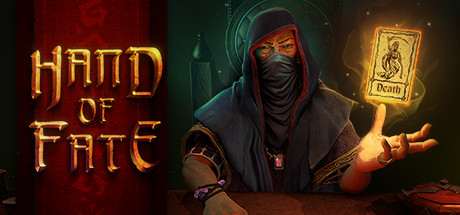 eo
game made by his studio in Brisbane, Defiant Development. But when
Defiant worked with an audio designer in Melbourne, more than 1,000
miles away, Mr. Jaffit knew it would be quicker to send a hard drive
by road than to upload the files, which could take several days. eo
game made by his studio in Brisbane, Defiant Development. But when
Defiant worked with an audio designer in Melbourne, more than 1,000
miles away, Mr. Jaffit knew it would be quicker to send a hard drive
by road than to upload the files, which could take several days.
“It’s really the big file sizes that kill us,” said Mr. Jaffit, the
company’s co-founder and creative director. “When we release an
update and there’s a small bug, that can kill us by three or four
days.”
Australia, a wealthy nation with a widely envied quality of life,
lags in one essential area of modern life: its internet speed. Eight
years after the country began an unprecedented broadband
modernization effort that will cost at least 49 billion Australian
dollars, its average internet speed lags that of the United States,
most of Western Europe, Japan and South Korea. In the most recent
ranking of internet speeds by Akamai, a networking company,
Australia came in at an embarrassing No. 51, trailing developing
economies like Thailand and Kenya.
For many in the US, slow broadband connections are a source of
frustration and an inspiration for gallows humour. One parody video
ponders what would happen if an American with a passion for
Instagram and streaming “Scandal” were to switch places with an
Australian resigned to taking bathroom breaks as her shows buffer.
It’s funny, you can see it
HERE.
But the problem goes beyond sluggish Netflix streams and slurred
Skype calls. Businesses complain that slow speeds hobble their
effectiveness and add to their costs. More broadly, Australia risks
being left behind at a time when countries like China and India are
looking to nurture their own start-up cultures to match the success
of Silicon Valley and keep their economies on the cutting edge.
“Poor broadband speeds will hold back Australia and its competitive
advantage,” said John O’Mahony, an economist at Deloitte Access Economics. A 2015 report by Deloitte valued the
nation’s digital economy at $58 billion and estimated that it could
be worth 50 percent more by 2020. “The speed of that growth is at
risk if we don’t have the broadband to support it,” he said.
at Deloitte Access Economics. A 2015 report by Deloitte valued the
nation’s digital economy at $58 billion and estimated that it could
be worth 50 percent more by 2020. “The speed of that growth is at
risk if we don’t have the broadband to support it,” he said.
The story of Australia’s costly internet bungle illustrates the
hazards of mingling telecommunication infrastructure with the
impatience of modern politics. The internet modernization plan has
been hobbled by cost overruns, partisan manoeuvring and a major
technical compromise that put 19th-century technology between the
country’s 21st-century digital backbone and many of its homes and
businesses.
The government-led push to modernize its telecommunications system
was unprecedented, experts say — and provides a cautionary tale for
others who might like to try something similar. “Australia was the
first country where a totally national plan to cover every house or
business was considered,” said Rod Tucker, a University of Melbourne
professor and a member of the expert panel that advised on the
effort. “The fact it was a government plan didn’t necessarily make
it doomed. In Australia, we have changes of governments every three
years, which really works against the ability to undertake long-term
planning, and the long-term rollouts of networks like this.”
Australia poses natural connectivity challenges. It lies oceans away
from other countries, and any network would have to connect
far-flung cities separated by its sparsely populated interior.
Still, Australia had high hopes for its ambitious internet project.
Started in 2009, the initiative, known as the National Broadband
Network, was intended to bring advanced fibre-optic technology to
the doorstep of just about every home and business. It was initially
estimated to cost 43 billion Australian dollars, shared by the
government and the private sector.
“Years of failed policy have left Australia as a broadband
backwater,” said Kevin Rudd, then the prime minister and leader of
the Labor Party. But the government share of those costs quickly
climbed until taxpayers were responsible for all of it. The
technology was slow to roll out, in part because of negotiations
with Telstra, Australia’s big telecommunications provider, over
installing the fibre. (A Telstra spokesman said the company did not
believe the talks added to delays.) The government-funded effort
drew fire from the Liberal Party, the opposition at the time, which
said the job should have been left to the private sector.
After a Liberal-led coalition was elected in 2013, that party looked
for ways to contain costs and speed up the rollout. They focused on
what in the telecommunications industry is called “the last mile” —
the wires that connect a home or business with the broader network.
While the National Broadband Network initially envisioned high-speed
fibre connecting homes and businesses directly to the network, the
Liberal-led effort compromised by connecting them with existing
copper wire, basically, the same technology used in the earliest
days of the telephone.
The result, critics say, was slow speeds that still did not stop
rising costs. “Australia had an aggressive, forward-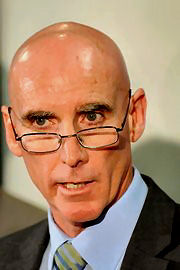 looking,
visionary government project to build a fibre network,” said Mike
Quigley, (left) who was chief executive of the project until 2013.
He added, “that opportunity’s been absolutely lost because of bad
judgments, ideologically and politically driven.” looking,
visionary government project to build a fibre network,” said Mike
Quigley, (left) who was chief executive of the project until 2013.
He added, “that opportunity’s been absolutely lost because of bad
judgments, ideologically and politically driven.”
A spokeswoman for the Liberal Party said that under its stewardship,
the initiative was connecting more new users than the Labour Party
ever did. But neither party placed fixing the internet high on their
campaign platforms in national elections last year, perhaps
indicating how difficult the problem will be to solve. Average
speeds have more than doubled since 2013, according to Akamai, but
other countries are connecting their populations faster, meaning
Australia’s lag with the rest of the world has grown. Big businesses
can opt to pay for fast connections, but the cost can be
considerable for smaller companies.
GO1, an education technology company near Brisbane, spent about
$22,000 on a speed upgrade in September 2015. It now pays nearly
$1,000 a month for its high-speed, 100 megabit connection. “As a
software company, our two main costs are internet and staff,” said
Andrew Barnes, the chief executive and co-founder. “If the former
was lower, then we have more to spend on building up the team.”
Mr. Barnes said that employees in Ho Chi Minh City, in Vietnam, had
far fewer issues joining the company’s weekly webinars. “Vietnam’s one of those countries where you look out the
window and the telephone wires are just a mess,” he said. “But
somehow, despite the obvious infrastructure problems, the internet
there is much, much better.”
webinars. “Vietnam’s one of those countries where you look out the
window and the telephone wires are just a mess,” he said. “But
somehow, despite the obvious infrastructure problems, the internet
there is much, much better.”
The video game industry in particular has pushed for better speeds.
“Right now, we are all on dirt roads,” Ben Britten, chief technology
officer at Mighty Games Group, said at a Senate hearing last year on
his industry’s future. “We are trying to push huge semi trucks down
dirt roads, and we just need to have some highways.”
Others, for their part, look for ways around the barriers —
including old-fashioned radio.
Nick Lorenzi, who lives in Cairns, in northeastern Queensland, was
frustrated with his copper-wire speeds, especially since a friend
just a few miles away had a much faster fibre connection.
Investigating online, Mr. Lorenzi, 25, an information technology
worker, found out how to bum bandwidth from the friend using two
transmitter dishes that cost $440 total. “I just knew that the
internet was rubbish where I was, so I thought, what else can I do
here?” he said. “I’m up really high on a hill, so I can take
advantage of that.”
Mr. Lorenzi has since moved, and he says his copper-based connection
speed once again is “just rubbish.” “For a country as far along as
we are, our internet’s just not aligned with that at all,” he said.
“It’s just pathetic, really.”
|
|
Run your
mouse over the pic below to see the alternative.
|
|
 |
|
|
|
Bullying.
A recent report by the Dept. of Defence Inspector General's Office
states that allegations of "a culture of widespread bullying and
brutality" within Defence are, in the most part, unfounded. The
audit team travelled to major Defence establishment across Australia
and abroad and interviewed staff from all services and few cases of
unfair treatment and bullying within the Army and Navy, however the
Air Force told a different story. Complaints came from a total of
3,555 Air Force members. While this statistic is alarming in its own
right, it becomes horrific when one considers that each complaint
represents a sad story of abuse, mistreatment and neglect. Examples
of the some of the more disturbing cases are shown below:
-
One young pilot told of having to spend two nights in tented
accommodations, despite the fact that there was an empty five-star
hotel just one mile away.
-
Another said that he had been forced to endure a gruelling fitness
test every year since he joined in 1997.
-
One airwoman alleged that she had been overlooked for promotion on
numerous occasions, simply because she was fat, lazy and stupid.
-
An aircraft maintenance technician stated he had been refused
permission to wear civilian attire to work, despite the fact that
his uniform clashed with his eye colour.
-
Another had been forced to wear uncomfortable safety boots for
periods of up to eight hours straight.
-
A clerk could not understand why she had been sent to work in a
Joint military headquarters, "I have been forced to work for
horrible Army people who just don't comprehend what the military is
all about. I feel the Air Force has victimized me by forcing me to
do this...I will be seeking compensation..."
-
Shockingly, Air Force senior ranks are also subject to mistreatment.
One SNCO stated, "I was deeply upset when I was addressed as
'Sergeant' by an officer. He knew my name was Robert. It was just
horrible - I have never been more humiliated in my life." A senior
officer advised that "the officer in question has been moved on...".
-
A number of personnel complained of having to attend courses that
were not relevant to their jobs, such as rigorous ground combat
courses and drawn-out lectures on occupational health and safety. To
add insult to injury, a young corporal was even ordered to pack up
chairs in the classroom after one such course.
The huge backlash against treatment of Air Force personnel should
provide senior officers with a vital clue with regard to the massive
retention problems experienced by the RAAF in recent times.
ANZAC Day.
I’m currently on the nomad trail, back in Feb I drove east from
Perth to “work” at the Avalon Air Show, after which I spent a few
weeks touring Tassy. I was in Launceston on ANZAC Day and as I
normally march I looked around for a group with which I could join.
I contacted the local Vietnam Vets association and they made me more
than welcome.
Thanks Lonny.
|
|
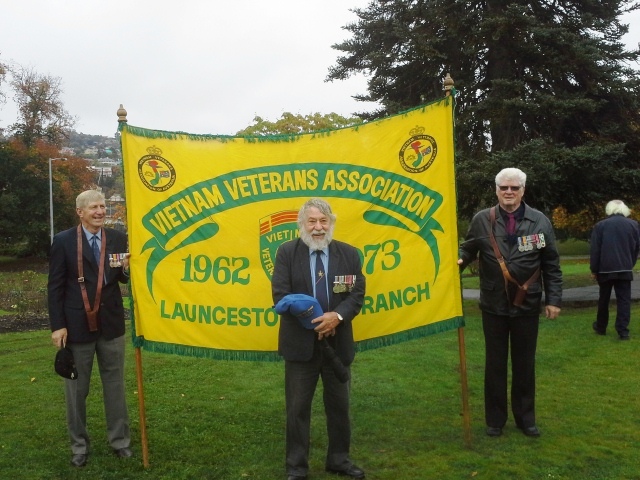 |
L-R:
Hennie Ebbelaar, Yours (Radtech extraordinaire), Viv
Hinds.
|
|
|
|
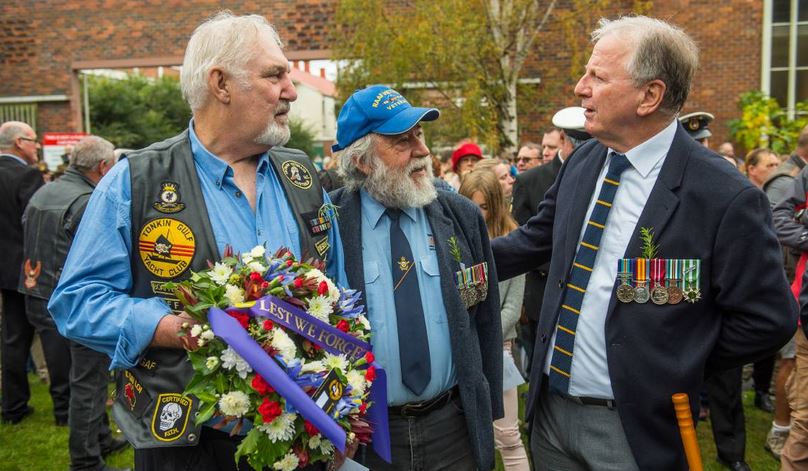 |
Vietnam veterans, Warwick Luttrell of Wynyard, yours truly from
Perth W.A
and Raymond Monery from Riverside (suburb of Launceston) preparing
to lay a wreath.
And even though the
weather wasn't all that brilliant, the wonderful people of
Launceston turned out in their thousands to stand and applaud the
efforts of the servicemen and women who marched through their
streets.
Click the pic below to
see the Vietnam Vets, could take a few seconds to load. (Look
for the blue cap).
(Video provided by the
Examiner Newspaper.)
|
|
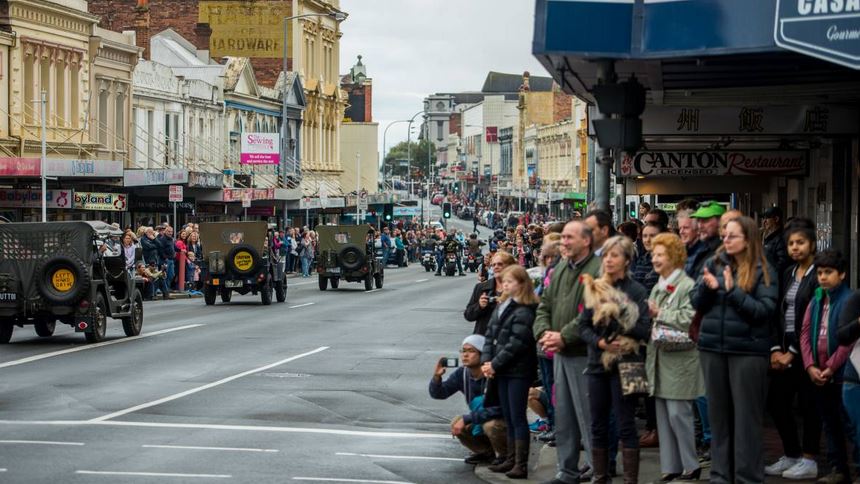 |
|
|
|
Why does salt make you thirsty?
When you eat a salty food, the salt passes through the wall of your
small intestine and enters your bloodstream and making the salt
content in your blood rise. As saltier-than-normal blood zooms
through veins and arteries, the body senses an imbalance. When
there's more salt in the fluid surrounding the cells than in the
cells themselves, the sodium-rich fluid attempts to pull even more
fluid out of the cells. It's a condition known as hypernatremia, and
it's a red flag that sends the cells' chemical messengers rushing to the brain to report
the high salt levels in the fluid around the cells and decry their
potential dehydration. "Water! Water! Water!" signals the brain and
voila! you're thirsty.
sends the cells' chemical messengers rushing to the brain to report
the high salt levels in the fluid around the cells and decry their
potential dehydration. "Water! Water! Water!" signals the brain and
voila! you're thirsty.
The "thirst centre" in your brain that compels you to reach for a
tall glass of water is located in the hypothalamus, which also helps
regulate sleep patterns, appetite and body temperature. When sensors
in the thirst centre receive signals that there's too much sodium in
the bloodstream because you binged on salty food, the hypothalamus
sends out an SOS: "Drink now."
Age and disease may inhibit the brain's ability to compel you to
take in fluids. In other words, people can lose their sense of
thirst, which is a dangerous condition considering the body is about
70 percent liquid and needs adequate hydration for its internal
organs to work properly. Proper hydration also aids the regulation
of body temperature and helps ensure that vitamins, hormones and
other substances get where they're needed.
Whether you're about to munch on some sodium-laden cured meats, a
salty snack or an extra sprinkling of salt, get ready to grab a big
glass of water. You're about to get really thirsty.
|
|
Foreign Aid.
In the financial year,
2016-17, your Australian Government gave the massive sum of
$3.8Billion dollars of your money to overseas countries in the form
of Aid. (See
HERE)
This $3.8Billion of
your dollars was firstly borrowed from other countries so your
government could give it away. You then go to work, pay your taxes
which then goes to pay the interest??
Some of the countries
that received a part of those funds are below: You can check
these figures by clicking each link.
|
|
| |
|
|
|
|
| |
Amount |
Receiving Country |
Link |
|
| |
$110M |
Iraq |
Here |
|
| |
$10M |
Yemen |
Here |
|
| |
$84.5M in 2016-17, then $80.9M 2017-18 |
Afghanistan |
Here |
|
| |
$82.9M in 2016-17, then $85M 2017-18 |
The Phillippines |
Here |
|
| |
$78.0M in 2016-17, then $66.4M in 2017-18 |
Myanmar |
Here |
|
| |
$547.1 in 2016-17, then $546.3 in 2017-18 |
PNG |
Here |
|
| |
$57.6M in 2016-17, then $57.9M in 2017-18 |
Bangladesh |
Here |
|
| |
$89.1M in 2016-17, then $87.4M in 2017-18 |
Cambodia |
Here |
|
| |
$86.6M in 2016, then $84.2M in 2017-18 |
Vietnam |
Here |
|
| |
$50.7M in 2016, then $47.1M in 2017-18 |
Pakistan |
Here |
|
| |
$29.0M in 2016-17, then $27.7M in 2017-18 |
Sri Lanka |
Here |
|
|
|
In the 2017-18
financial year the figure will rise to $3.9Billion yet we have Ex-ADF
personnel who are suiciding due lack of care, we have 105,237 people
in Australia living on the streets and we have farmers, business
people and families waiting on disaster relief after Cyclone Debbie.
We're running out of Electricity, some of our roads are goat tracks,
our natural gas is far too dear and seriously ill people can wait for
months, sometimes years, for aid.
But!! We
can stump up $3.9Billion for people overseas???
Something's definitely
wrong!!
|
|
One good deed??
Back on January 9th, a group of HELLS ANGELS, South Carolina bikers
were riding east on 378 when they saw a girl about to jump off the
Pee Dee River Bridge . So they stopped.
George, their leader, a big burly man of 53, gets off his Harley,
walks through a group of gawkers, past the State Trooper who was
trying to talk her down off the railing, and says, "Hey Baby . . .
whatcha doin' up there on that railin'?"
She says tearfully, "I'm going to commit suicide!!"
While he didn't want to appear "sensitive," George also didn't want
to miss this "be-a-legend" opportunity either so he asked . . ..
"Well, before you jump, Honey-Babe . . .why don't you give ol'
George here your best last kiss?"
So, with no hesitation at all, she leaned back over the railing and
did just that . . .and it was a long, deep, lingering kiss followed
immediately by another even better one.
After they breathlessly finished, George gets a big thumbs-up
approval from his biker-buddies, the onlookers, and even the State
Trooper, and then says, "Wow! That was the best kiss I have ever
had! That's a real talent you're wasting there, Sugar Shorts. You
could be famous if you rode with me. Why are you committing
suicide?"
"My parents don't like me dressing up like a girl."
It's still unclear whether she jumped or was pushed.
|
|
|
You have to pay close
attention these days to keep up with all the breathless news about
“flying cars” and “disruptive aerial vehicles.” The great and the
good from the technology world have fallen in love with aviation
lately, and their various startup companies have been launching
aviation projects at an unprecedented rate in 2017. More than
modifications to existing airplanes, each new design seems to be
more fantastical than the last.
Here are just a few stories that have made news in the last
month:
-
Google co-founder Larry Page is
behind Kitty Hawk, a company that took the wraps off its “flying
car” this week with a sexy video.
It looks a whole lot more like a flying jet ski than a car, and it’s
actually a Part 103 ultralight so it won’t require a pilot
certificate.
-
Not to be outdone, Google’s other
co-founder, Sergey Brin, seems to be building
a large airship at the NASA Ames Research Center in California.
Plans for commercial introduction are still unclear at this point.
-
Skype founder Niklas Zennström also
showed off his big idea this month. Lilium, an
all-electric flying car with vertical takeoff and landing
capabilities, made its first flight in Europe recently and promises
some impressive performance numbers.
-
At the swanky Top
Marques Monaco event this week, Slovakia-based
AeroMobil
opened the order book for its supercar-with-wings, which is the
closest thing to a real flying car yet. It’s priced at $1.5 million,
and requires a pilot – for now.
-
Proving that flashy
headlines aren’t just for startups, Boeing and JetBlue
announced an investment in ZunumAero, a Seattle company that
thinks it can build an electric, short-haul airliner that will cut
airfares by 50%.
What precipitated this mad
dash into concept aircraft? There are as many theories as there are
startups right now, but the most likely ones are also the most
mundane. A lot of the gold rush mentality is just the way the
venture capital-fueled technology industry works these days.
Everyone is paranoid about missing the next Facebook and being left
behind, so interest and money quickly shift from trend to trend at
the first sight of change. Since one of the hottest trends in recent
years has been drones, many of these flying projects can be viewed
as basically grown-up versions of quadcopters. Plus, for billionaire founders and dominant
companies, a $100 million bet on a crazy aviation startup is about
like you and me dropping $10 on a lottery ticket.
of quadcopters. Plus, for billionaire founders and dominant
companies, a $100 million bet on a crazy aviation startup is about
like you and me dropping $10 on a lottery ticket.
Uber's push for airborne taxis by 2020
is driving a lot of the headlines right now.
But perhaps the most important
driver of flying car startups has been Uber. The fast-growing,
money-losing company has made no secret of
its plans to take its taxi service airborne, forever changing
urban commutes with a vast fleet of unmanned vertical takeoff and
landing (VTOL) aircraft. This effort seems to have brought a lot of
hobby projects into the daylight, and a conference hosted by Uber
this week shows just how pervasive the drone fever is right now. A
diverse group of companies took the stage to announce
radical designs and make increasingly bold predictions, including
Embraer, Bell
Helicopter, and a
Mooney-Carter partnership.
Such attention is downright
exciting for pilots, who have long made do with minor upgrades to
60-year old airplanes. Finally, the best minds in the world are
talking about truly new aircraft and bold ideas! While the buzz
certainly is intoxicating, it’s almost guaranteed that this bubble –
and it is a bubble – will burst. At least three forces are acting
against these aviation startups: regulation, technology, and
attention span.
The most obvious obstacle for
these aviation startups is the regulatory environment. Tech firms
use catchy phrases like, “move fast and break things” to signify
their casual disregard for the rules, and that’s often successful
(as Uber has rather spectacularly proven). As these companies will
soon find out, though, aviation is quite different. Unlike many
areas of the technology industry, the rules are well-established –
perhaps too well-established – so there are few gray areas to hide
in.
One of those rules involves
powerplants. Almost all of the recently-announced aircraft use
electric motors, which are nearly impossible to certify right now.
Strapping eight of them to the wings and then tilting them for
takeoff can work, but don’t expect a type certificate for such a
design to appear overnight.
On top of the electric motors, the
business models for these airborne Ubers depend on autonomous flight
if they plan to make money. While the FAA has released final rules
for small unmanned aircraft, these only apply to aircraft under 55
lbs. There is a long way to go before a comparable rulebook is in
place for 5,000 lb. drones that carry passengers. One key issue to
solve is “sense-and-avoid,” the ability for an unmanned aircraft to
avoid a mid-air collision with an airplane. There are various ideas
for tackling this issue, but formal trials won’t be complete until
at least 2020, with the final decision probably even later. For
perspective, consider that Europe allowed commercial operators to
use single engine turboprops on IFR flights last year, and
only after decades of debate and study. Why will autonomous Part 135
or 121 operators move so much faster? final decision probably even later. For
perspective, consider that Europe allowed commercial operators to
use single engine turboprops on IFR flights last year, and
only after decades of debate and study. Why will autonomous Part 135
or 121 operators move so much faster?
An all-electric, unmanned Slowed Rotor Compound
aircraft
should be easy to certify, right?
Perhaps most importantly, unmanned
air taxis will have to do battle with a single, nationwide regulator
for aviation. While Uber is no stranger to legal battles, until now
they have benefited from the fractured nature of their opponents –
San Francisco Board of Supervisors here, the state of New York
there. When it comes to flying cars, there can be no jurisdictional
arbitrage; if the FAA doesn’t approve, it’s not going to happen.
Beyond the legal challenges, there
are big technical problems to solve, too. Electric motors,
lightweight batteries, tilt rotors, and autonomous flight
controllers may not be science fiction at this point, but they’re
hardly mature technologies. Many of them depend on continuing
development in the smartphone and electric car industries. While the critical
components will eventually get made, the key questions are: at what
price and on what timeline? In particular, the schedule for these
new aircraft is incredibly aggressive. Uber plans to launch its
Elevate service by 2020 – a mere 32 months from now. That is nearly
unthinkable given the current state of technology, regulation, and
public perception.
It’s also worth considering how
well these aircraft will solve the problems they hope to take on,
notably traffic congestion. As Zennström said recently, “The way we
deal with transportation today is broken. There are congestions and
to get from East London to West London takes forever. There is
pollution in our cities with carbon dioxide so we get climate
change.”
VTOL aircraft certainly do
eliminate the restrictions imposed by road infrastructure, but they
hardly eliminate the idea of traffic. Crucially, Uber isn’t so much
solving the capacity issue as it is moving where the problem exists.
Take a commonly-used example: New York on a Friday afternoon, when
thousands of people want to get from Manhattan to JFK Airport at
5pm. Right now the only real option is an hourlong car trip through
heavy traffic, but the cheerleaders suggest that could be cut
down to five minutes in an Uber Elevate. In flying time it certainly
could, but where will all of these aircraft land? At 4-6 people per
Uber, it would take hundreds of drones to satisfy demand. They may
be able to fly their own routes, but they will eventually need a
place to land. As we’ve learned in aviation, the real bottleneck is
often the number of runways, not the airspace.
Uber is working with real estate
developers to address this issue, but I suspect they haven’t
considered how vocal the NIMBY crowd can be when aircraft are
involved. Cars are a part of everyday life; tilt rotor aircraft are
not. Even if the neighbors do go along, this will be a very
capital-intensive effort. Uber (or its partners) will have to own a
lot of land for vertiports, and have a large fleet of aircraft.
Neither of those exist in the company’s current business model,
which is the ultimate “asset light” strategy. Indeed, one of the key
breakthroughs for the company now is making use o f existing capacity
(garages and cars) that is sits idle most of the day. Building a
network of facilities and aircraft from scratch is a different story
altogether. f existing capacity
(garages and cars) that is sits idle most of the day. Building a
network of facilities and aircraft from scratch is a different story
altogether.
Will investors like Larry Page simply lose interest?
Regulation and technology are
perpetual enemies of aircraft development programs, but the third
reason for skepticism is less common in this industry: investors
will simply lose interest and move onto the next idea. For anyone
used to rapid development cycles in software, aviation must feel
utterly unbearable with its lengthy testing programs and
mind-numbing certification rituals. In fact, the attitude it takes
to run a successful technology company is almost the exact opposite
of the one it takes to bring a new aircraft to market. It’s easy to
see how, after a few years of being stuck in the mud and wasting a
few hundred million dollars, billionaire investors will simply punt.
That’s not necessarily a criticism, it’s just the way their business
works. Technology investors know they will strike out far more often
than they will get a hit, but it only takes a few really big hits to
win. When it’s clear that a flying car isn’t going to be the next
multi-billion dollar company, it will disappear.
None of this is to suggest that
autonomous flying cars won’t exist someday. I look forward to riding
in one before I die, but the outrageously ambitious schedule being
promoted right now is a publicity stunt, not a realistic plan. I
suspect most of the people involved know this, but keep up the
charade to fuel the hype cycle.
It’s not all doom and gloom. When
this bubble pops, there could be some very real benefits that
trickle down to general aviation pilots. It seems increasingly
likely that the future of recreational aviation, if perhaps not
cross-country flying, will be electric. If general aviation
manufacturers can free-ride on some of the advances in electric
flight and autonomous technologies, we could end up with a
new generation of bugsmashers. That’s something to look forward to,
no matter what you fly today.
So I welcome our new visitors to
the bizarre world of aviation, but I recommend we all keep our hands
on our wallets and our eyes on the FAA. When it’s over, maybe we’ll
have something to celebrate.
|
|
|
|
Blessed are those who are cracked,
for they are the ones who let in the light!
 |
|
Ok, Ok!! – I’m going back to my room now!!
|
|
|
| |
|
|
|
|
 of quadcopters. Plus, for billionaire founders and dominant
companies, a $100 million bet on a crazy aviation startup is about
like you and me dropping $10 on a lottery ticket.
of quadcopters. Plus, for billionaire founders and dominant
companies, a $100 million bet on a crazy aviation startup is about
like you and me dropping $10 on a lottery ticket. final decision probably even later. For
perspective, consider that Europe allowed commercial operators to
use single engine turboprops on IFR flights last year, and
only after decades of debate and study. Why will autonomous Part 135
or 121 operators move so much faster?
final decision probably even later. For
perspective, consider that Europe allowed commercial operators to
use single engine turboprops on IFR flights last year, and
only after decades of debate and study. Why will autonomous Part 135
or 121 operators move so much faster? f existing capacity
(garages and cars) that is sits idle most of the day. Building a
network of facilities and aircraft from scratch is a different story
altogether.
f existing capacity
(garages and cars) that is sits idle most of the day. Building a
network of facilities and aircraft from scratch is a different story
altogether.







 actually protects against brain-cell death. If this sounds
counterintuitive and perplexing, the scientists could only agree.
Until recently, they weren’t sure what was going on. The celebrated
health-giving antioxidants in red wine are assumed to play a part by
reducing oxidative stress – where your body struggles to detoxify
dangerous chain reactions at an atomic level – but scientists know
that other factors are at play, because more significant destructive
processes are also being curtailed.
actually protects against brain-cell death. If this sounds
counterintuitive and perplexing, the scientists could only agree.
Until recently, they weren’t sure what was going on. The celebrated
health-giving antioxidants in red wine are assumed to play a part by
reducing oxidative stress – where your body struggles to detoxify
dangerous chain reactions at an atomic level – but scientists know
that other factors are at play, because more significant destructive
processes are also being curtailed. (responsible for the confusion and loss of memory in Alzheimer’s);
suppresses neuroinflammation, modulates (keeps steady) signalling
pathways and decreases mitochondrial dysfunction. The mitochondria
is the powerhouse in our cells; if it goes out of whack, the cell
dies.
(responsible for the confusion and loss of memory in Alzheimer’s);
suppresses neuroinflammation, modulates (keeps steady) signalling
pathways and decreases mitochondrial dysfunction. The mitochondria
is the powerhouse in our cells; if it goes out of whack, the cell
dies. eo
game made by his studio in Brisbane, Defiant Development. But when
Defiant worked with an audio designer in Melbourne, more than 1,000
miles away, Mr. Jaffit knew it would be quicker to send a hard drive
by road than to upload the files, which could take several days.
eo
game made by his studio in Brisbane, Defiant Development. But when
Defiant worked with an audio designer in Melbourne, more than 1,000
miles away, Mr. Jaffit knew it would be quicker to send a hard drive
by road than to upload the files, which could take several days. looking,
visionary government project to build a fibre network,” said Mike
Quigley, (left) who was chief executive of the project until 2013.
He added, “that opportunity’s been absolutely lost because of bad
judgments, ideologically and politically driven.”
looking,
visionary government project to build a fibre network,” said Mike
Quigley, (left) who was chief executive of the project until 2013.
He added, “that opportunity’s been absolutely lost because of bad
judgments, ideologically and politically driven.” webinars. “Vietnam’s one of those countries where you look out the
window and the telephone wires are just a mess,” he said. “But
somehow, despite the obvious infrastructure problems, the internet
there is much, much better.”
webinars. “Vietnam’s one of those countries where you look out the
window and the telephone wires are just a mess,” he said. “But
somehow, despite the obvious infrastructure problems, the internet
there is much, much better.”

 sends the cells' chemical messengers rushing to the brain to report
the high salt levels in the fluid around the cells and decry their
potential dehydration. "Water! Water! Water!" signals the brain and
voila! you're thirsty.
sends the cells' chemical messengers rushing to the brain to report
the high salt levels in the fluid around the cells and decry their
potential dehydration. "Water! Water! Water!" signals the brain and
voila! you're thirsty.

